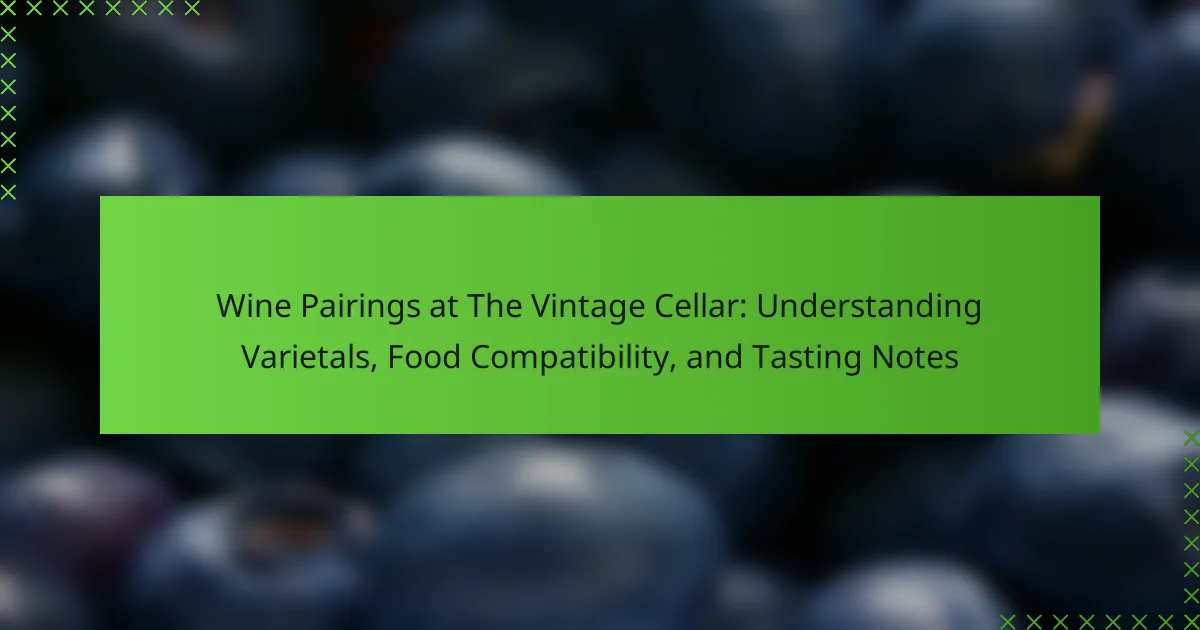
What are Wine Pairings at The Vintage Cellar?
Wine pairings at The Vintage Cellar refer to the recommended combinations of wines with specific foods. These pairings enhance the dining experience by complementing flavors. The Vintage Cellar offers a selection of wines categorized by varietals. Each varietal has distinct tasting notes that align with various cuisines. For example, a Cabernet Sauvignon pairs well with red meats. In contrast, a Chardonnay complements seafood dishes. The staff at The Vintage Cellar provides personalized recommendations based on customer preferences. This ensures that guests find the ideal wine for their meal.
How do wine pairings enhance the dining experience?
Wine pairings enhance the dining experience by complementing and elevating the flavors of food. When a wine is paired correctly, it can highlight the dish’s ingredients. For example, a crisp white wine can balance the richness of creamy sauces. Red wines often enhance the savory notes of grilled meats. This synergy can create a more enjoyable tasting experience. Studies show that proper pairings can improve overall meal satisfaction. According to research by the American Journal of Enology and Viticulture, wine can influence flavor perception. Thus, thoughtful wine pairings contribute significantly to a memorable dining experience.
What factors influence successful wine pairings?
Successful wine pairings are influenced by several key factors. The primary factor is the compatibility of flavors between the wine and the food. For instance, a rich, full-bodied red wine complements hearty dishes like steak. The acidity of the wine also plays a crucial role. High-acid wines can balance fatty foods, enhancing the overall dining experience. Additionally, the intensity of flavors must match. A delicate dish requires a lighter wine to avoid overpowering it.
The sweetness level is another important aspect. Sweet wines can pair well with spicy foods, as they counteract heat. Tannins in red wines can interact with proteins in meats, softening the overall taste. Lastly, regional pairings often enhance the experience. Local wines and dishes typically have a harmonious relationship, reflecting the terroir. These factors collectively contribute to successful wine pairings.
How does The Vintage Cellar approach wine pairings?
The Vintage Cellar approaches wine pairings by emphasizing the compatibility of wine varietals with specific foods. They consider factors such as flavor profiles, acidity, and body when recommending pairings. The staff is trained to understand how different wines enhance the dining experience. This includes matching the intensity of the wine with the weight of the dish. They also provide tasting notes to guide customers in their selections. The approach is rooted in both tradition and customer preferences. This method ensures a personalized experience for each customer.
What varietals are offered at The Vintage Cellar?
The Vintage Cellar offers a diverse selection of wine varietals. Common varietals include Cabernet Sauvignon, Merlot, Chardonnay, and Pinot Noir. Other options may include Sauvignon Blanc and Zinfandel. The varietals are sourced from various regions, enhancing their unique characteristics. Each varietal has distinct flavor profiles and food pairing suggestions. This variety caters to different palates and preferences. The Vintage Cellar’s extensive collection allows for exploration of both popular and niche varietals.
What are the characteristics of popular varietals?
Popular varietals exhibit distinct characteristics that define their profiles. For instance, Cabernet Sauvignon is known for its full body and high tannins. It often presents flavors of dark fruit, such as blackberry and plum. Chardonnay, on the other hand, can be either oaked or unoaked, influencing its buttery or crisp profile. Pinot Noir is lighter in body, showcasing red fruit flavors like cherry and raspberry. Sauvignon Blanc is typically zesty and aromatic, with notes of citrus and green herbs. Merlot is softer and fruitier, often featuring plum and chocolate notes. Each varietal’s unique attributes are influenced by factors such as terroir and winemaking techniques. This diversity in characteristics allows for varied food pairings, enhancing the overall wine experience.
How do different varietals complement various cuisines?
Different varietals complement various cuisines by enhancing flavors and balancing textures. For example, a Sauvignon Blanc pairs well with fresh seafood due to its acidity. This acidity cuts through the richness of dishes like buttery lobster. Similarly, a Cabernet Sauvignon complements red meats, as its tannins soften the meat’s proteins. A Pinot Noir matches well with earthy dishes, such as mushroom risotto, because of its subtle fruitiness.
Chardonnay is versatile, pairing with creamy sauces and poultry. Its buttery notes enhance the richness of dishes like chicken Alfredo. Additionally, Riesling’s sweetness can offset spicy Asian cuisines, creating a harmonious balance. Each varietal’s unique characteristics interact with the flavors of food, creating an enjoyable dining experience. Thus, understanding varietals is crucial for optimal wine pairings.

What is the significance of food compatibility in wine pairings?
Food compatibility in wine pairings enhances the overall dining experience. It ensures that the flavors of the food and wine complement each other. For example, acidic wines pair well with rich, fatty dishes. This balance can elevate the taste perception of both the food and the wine. Studies show that proper pairings can improve flavor intensity and enjoyment. The right match can also highlight specific notes in the wine. Therefore, food compatibility is crucial in maximizing the sensory experience of wine.
How does food interaction affect wine flavors?
Food interaction significantly affects wine flavors by altering perceptions of taste and aroma. When food is consumed with wine, it can enhance or diminish specific flavor notes. For example, fatty foods can soften tannins in red wine, making it taste smoother. Conversely, acidic foods can amplify the acidity of wine, making it taste sharper.
The combination of flavors creates a sensory experience that can change the overall profile of the wine. Research indicates that pairing wine with complementary foods can enhance the enjoyment of both. A study published in the Journal of Wine Research highlighted that wine and food pairings could create a more balanced and harmonious flavor profile.
Thus, the interaction between food and wine is crucial in shaping the tasting experience. The right pairings can elevate both the wine and the dish, leading to a more satisfying meal.
What are the basic principles of food and wine pairing?
The basic principles of food and wine pairing include matching flavors, balancing acidity, and considering the weight of the dish. Matching flavors involves aligning the dominant taste profiles of both the food and wine. For example, a fruity wine complements a dish with sweet elements. Balancing acidity is crucial; high-acid wines pair well with rich or fatty foods, as they cut through the richness. Considering the weight of the dish means that lighter wines suit lighter dishes, while fuller-bodied wines pair with heartier meals. These principles guide the selection process to enhance the overall dining experience.
How can one identify food that pairs well with specific wines?
To identify food that pairs well with specific wines, one should consider the wine’s flavor profile. Different wines have distinct characteristics such as acidity, sweetness, and tannins. Foods that complement these characteristics enhance the overall dining experience. For example, acidic wines like Sauvignon Blanc pair well with tart foods like goat cheese. Rich red wines, such as Cabernet Sauvignon, match well with hearty dishes like steak.
Research shows that pairing wine with food can enhance flavors and aromas. A study published in the Journal of Food Science found that wine and food pairings can significantly affect taste perception. This suggests that understanding the basic principles of flavor compatibility is essential for successful pairings.
What role do tasting notes play in wine selection?
Tasting notes play a crucial role in wine selection by providing detailed descriptions of a wine’s aroma, flavor, and texture. These notes help consumers understand the wine’s profile and characteristics. Tasting notes often include specific terms such as fruity, floral, or earthy. This language guides buyers in matching wines to their personal preferences. Additionally, tasting notes can indicate the wine’s aging potential and food pairings. According to a study published in the Journal of Wine Research, consumers often rely on tasting notes to make informed purchasing decisions. Thus, tasting notes serve as an essential tool for enhancing the wine selection process.
How can tasting notes guide food pairing decisions?
Tasting notes guide food pairing decisions by highlighting flavor profiles and aromas in wine. These notes detail specific attributes like fruitiness, acidity, and tannins. For example, a wine described as having high acidity pairs well with rich, fatty foods. This is because acidity cuts through fat, enhancing the overall dining experience. Similarly, wines with fruity notes complement dishes that have sweet or savory elements. This creates a harmonious balance on the palate. Additionally, tasting notes can indicate the body of the wine, which influences pairing with heavier or lighter dishes. A full-bodied wine pairs better with robust flavors, while a light-bodied wine suits delicate dishes. Hence, understanding tasting notes is essential for making informed food pairing choices.
What are the common tasting notes found in wines at The Vintage Cellar?
Common tasting notes in wines at The Vintage Cellar include fruity, floral, and earthy characteristics. Fruity notes often feature flavors such as cherry, blackberry, and citrus. Floral notes can present aromas like jasmine or rose. Earthy characteristics may include hints of soil or mushroom. These tasting notes vary by varietal and region. For example, Cabernet Sauvignon typically exhibits blackcurrant and cedar notes. Pinot Noir often showcases red fruit and spice. The diversity of these notes enhances the wine tasting experience.

What are some practical tips for successful wine pairings?
Successful wine pairings enhance the dining experience. Start by matching the wine’s body with the food’s weight. Light wines pair well with lighter dishes, while full-bodied wines complement richer foods. Consider the flavor profiles; sweet wines balance spicy dishes, while acidic wines cut through fatty foods. Use regional pairings; wines often complement local cuisines. Experiment with contrasting flavors for unexpected pairings. Lastly, trust personal preferences; enjoyment is paramount in wine pairing.
How can one experiment with wine pairings at home?
To experiment with wine pairings at home, start by selecting various wines and foods. Choose a range of wine varietals, such as red, white, and sparkling. Pair these wines with different food types, including meats, cheeses, and vegetables.
Taste each combination to assess flavors and aromas. Note which pairings enhance the meal and which do not work well. Use a journal to document your observations.
This method allows for personalized discovery of what works for your palate. Research shows that wine pairing can enhance the dining experience significantly, as supported by studies on flavor compatibility.
What are some common mistakes to avoid in wine pairing?
Common mistakes to avoid in wine pairing include overlooking the weight of the dish. Light dishes require lighter wines, while heavier dishes pair better with full-bodied wines. Another mistake is ignoring acidity levels. High-acid wines can enhance dishes with similar acidity, while low-acid wines may clash. Additionally, pairing wine with overly spicy foods can overwhelm the wine’s flavors. Failing to consider sweetness is also a mistake. Sweet wines should be paired with equally sweet dishes to avoid bitterness. Lastly, relying solely on personal preference without considering the food’s characteristics can lead to poor pairings.
How can seasonal ingredients influence wine pairing choices?
Seasonal ingredients significantly influence wine pairing choices by enhancing flavor compatibility. Fresh, seasonal produce often exhibits vibrant flavors that can complement or contrast with specific wine varietals. For example, spring vegetables like asparagus pair well with Sauvignon Blanc due to their grassy notes. In contrast, hearty winter root vegetables can harmonize with fuller-bodied reds like Cabernet Sauvignon. Seasonal ingredients also reflect the terroir, creating a sense of place that resonates with local wines. This connection can elevate the dining experience, making it more cohesive and enjoyable. Ultimately, aligning wine with seasonal ingredients showcases the best of both the food and the wine, creating a balanced and satisfying pairing.
Wine pairings at The Vintage Cellar focus on the recommended combinations of wines with specific foods to enhance the dining experience. The article explores how different varietals, such as Cabernet Sauvignon and Chardonnay, complement various cuisines through their unique attributes and tasting notes. Key factors influencing successful pairings include flavor compatibility, acidity, and the weight of dishes. Additionally, the significance of food interaction and seasonal ingredients in wine selection is discussed, along with practical tips for achieving optimal pairings. Understanding these elements contributes to a more enjoyable and memorable wine experience at The Vintage Cellar.
